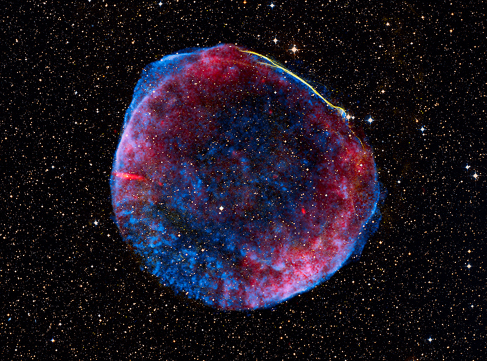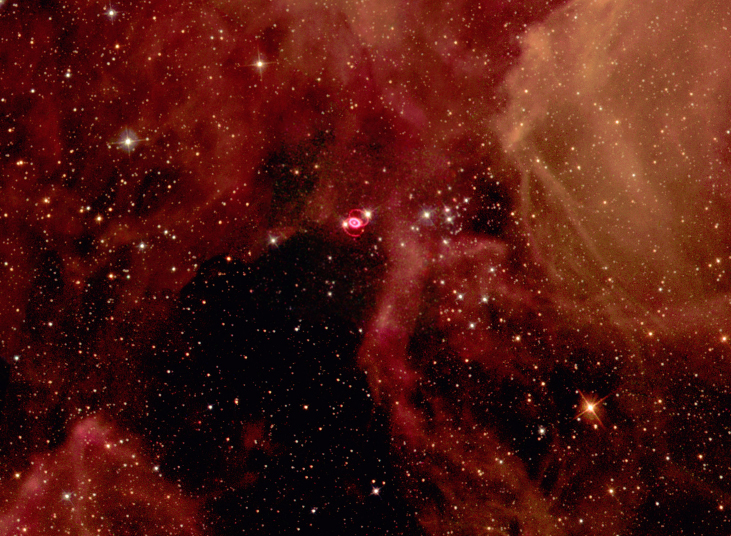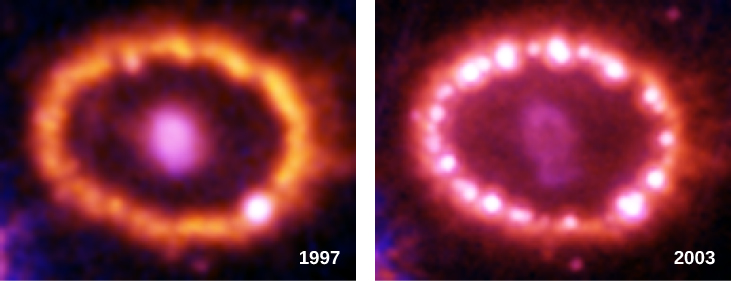11.11 Supernova Observations
Supernovae were discovered long before astronomers realized that these spectacular cataclysms mark the death of stars. The word nova means “new” in Latin; before telescopes, when a star too dim to be seen with the unaided eye suddenly flared up in a brilliant explosion, observers concluded it must be a brand-new star. Twentieth-century astronomers reclassified the explosions with the greatest luminosity as supernovae.
From historical records of such explosions, from studies of the remnants of supernovae in our Galaxy, and from analyses of supernovae in other galaxies, we estimate that, on average, one supernova explosion occurs somewhere in the Milky Way Galaxy every 25 to 100 years. Unfortunately, however, no supernova explosion has been observable in our Galaxy since the invention of the telescope. Either we have been exceptionally unlucky or, more likely, recent explosions have taken place in parts of the Galaxy where interstellar dust blocks light from reaching us.
Supernovae in History
Although many supernova explosions in our own Galaxy have gone unnoticed, a few were so spectacular that they were clearly seen and recorded by sky watchers and historians at the time. We can use these records, going back two millennia, to help us pinpoint where the exploding stars were and thus where to look for their remnants today.
The most dramatic supernova was observed in the year 1006. It appeared in May as a brilliant point of light visible during the daytime, perhaps 100 times brighter than the planet Venus. It was bright enough to cast shadows on the ground during the night and was recorded with awe and fear by observers all over Europe and Asia. No one had seen anything like it before; Chinese astronomers, noting that it was a temporary spectacle, called it a “guest star.”
Astronomers David Clark and Richard Stephenson have scoured records from around the world to find more than 20 reports of the 1006 supernova (SN 1006) which is pictured in Figure 11.23. This has allowed them to determine with some accuracy where in the sky the explosion occurred. They place it in the modern constellation of Lupus; at roughly the position they have determined, we find a supernova remnant, now quite faint. From the way its filaments are expanding, it indeed appears to be about 1000 years old.
Supernova 1006 Remnant

SN 1006 Supernova Remnant by NASA, ESA, Zolt Levay(STScI), NASA Media License.
Another guest star, now known as SN 1054, was clearly recorded in Chinese records in July 1054. The remnant of that star is one of the most famous and best-studied objects in the sky, called the Crab Nebula. It is a marvellously complex object, which has been key to understanding the death of massive stars. When its explosion was first seen, we estimate that it was about as bright as the planet Jupiter: nowhere near as dazzling as the 1006 event but still quite dramatic to anyone who kept track of objects in the sky. Another fainter supernova was seen in 1181.
The next supernova became visible in November 1572 and, being brighter than the planet Venus, was quickly spotted by a number of observers, including the young Tycho Brahe. His careful measurements of the star over a year and a half showed that it was not a comet or something in Earth’s atmosphere since it did not move relative to the stars. He correctly deduced that it must be a phenomenon belonging to the realm of the stars, not of the solar system. The remnant of Tycho’s Supernova (as it is now called) can still be detected in many different bands of the electromagnetic spectrum.
Not to be outdone, Johannes Kepler, Tycho Brahe’s scientific heir, found his own supernova in 1604, now known as Kepler’s Supernova. Fainter than Tycho’s, it nevertheless remained visible for about a year. Kepler wrote a book about his observations that was read by many with an interest in the heavens, including Galileo.
No supernova has been spotted in our Galaxy for the past 300 years. Since the explosion of a visible supernova is a chance event, there is no way to say when the next one might occur. Around the world, dozens of professional and amateur astronomers keep a sharp lookout for “new” stars that appear overnight, hoping to be the first to spot the next guest star in our sky and make a little history themselves.
At their maximum brightness, the most luminous supernovae have about 10 billion times the luminosity of the Sun. For a brief time, a supernova may outshine the entire galaxy in which it appears. After maximum brightness, the star’s light fades and disappears from telescopic visibility within a few months or years. At the time of their outbursts, supernovae eject material at typical velocities of 10,000 kilometres per second (and speeds twice that have been observed). A speed of 20,000 kilometres per second corresponds to about 45 million miles per hour, truly an indication of great cosmic violence.
Supernovae are classified according to the appearance of their spectra, but in this chapter, we will focus on the two main causes of supernovae. Type Ia supernovae are ignited when a lot of material is dumped on degenerate white dwarfs as shown in Figure 11.24; these supernovae will be discussed later in this chapter. For now, we will continue our story about the death of massive stars and focus on type II supernovae, which are produced when the core of a massive star collapses.
Supernova 2014J

Hubble Monitors Supernova In Nearby Galaxy M82 by NASA, ESA, A. Goobar (Stockholm University), and the Hubble Heritage Team (STScI/AURA), NASA Media Licence.
Supernova 1987A
Our most detailed information about what happens when a type II supernova occurs comes from an event that was observed in 1987. Before dawn on February 24, Ian Shelton, a Canadian astronomer working at an observatory in Chile, pulled a photographic plate from the developer. Two nights earlier, he had begun a survey of the Large Magellanic Cloud, a small galaxy that is one of the Milky Way’s nearest neighbours in space. Where he expected to see only faint stars, he saw a large bright spot. Concerned that his photograph was flawed, Shelton went outside to look at the Large Magellanic Cloud . . . and saw that a new object had indeed appeared in the sky as shown in Figure 11.25. He soon realized that he had discovered a supernova, one that could be seen with the unaided eye even though it was about 160,000 light-years away.
Hubble Space Telescope Image of SN 1987A

SN 1987a in the Large Magellanic Cloud by the Hubble Heritage Team (AURA/STScI/NASA/ESA), ESA Standard Licence.
Now known as SN 1987A, since it was the first supernova discovered in 1987, this brilliant newcomer to the southern sky gave astronomers their first opportunity to study the death of a relatively nearby star with modern instruments. It was also the first time astronomers had observed a star before it became a supernova. The star that blew up had been included in earlier surveys of the Large Magellanic Cloud, and as a result, we know the star was a blue supergiant just before the explosion.
By combining theory and observations at many different wavelengths, astronomers have reconstructed the life story of the star that became SN 1987A. Formed about 10 million years ago, it originally had a mass of about 20 MSun. For 90% of its life, it lived quietly on the main sequence, converting hydrogen into helium. At this time, its luminosity was about 60,000 times that of the Sun (LSun), and its spectral type was O. When the hydrogen in the centre of the star was exhausted, the core contracted and ultimately became hot enough to fuse helium. By this time, the star was a red supergiant, emitting about 100,000 times more energy than the Sun. While in this stage, the star lost some of its mass.
This lost material has actually been detected by observations with the Hubble Space Telescope as shown in Figure 11.26. The gas driven out into space by the subsequent supernova explosion is currently colliding with the material the star left behind when it was a red giant. As the two collide, we see a glowing ring.
Ring around Supernova 1987A

Modification of Hubble Supernova 1987A Scrapbook (1994-2003) by NASA, P. Challis, R. Kirshner (Harvard-Smithsonian Center for Astrophysics) and B. Sugerman (STScI), ESA Standard Licence.
Helium fusion lasted only about 1 million years. When the helium was exhausted at the centre of the star, the core contracted again, the radius of the surface also decreased, and the star became a blue supergiant with a luminosity still about equal to 100,000 LSun. This is what it still looked like on the outside when, after brief periods of further fusion, it reached the iron crisis we discussed earlier and exploded.
Some key stages of evolution of the star that became SN 1987A, including the ones following helium exhaustion, are listed in Table 11.7. While we don’t expect you to remember these numbers, note the patterns in the table: each stage of evolution happens more quickly than the preceding one, the temperature and pressure in the core increase, and progressively heavier elements are the source of fusion energy. Once iron was created, the collapse began. It was a catastrophic collapse, lasting only a few tenths of a second; the speed of infall in the outer portion of the iron core reached 70,000 kilometres per second, about one-fourth the speed of light.
| Phase | Central Temperature (K) | Central Density (g/cm3) | Time Spent in This Phase |
|---|---|---|---|
| Hydrogen fusion | 40 × 106 | 5 | 8 × 106 years |
| Helium fusion | 190 × 106 | 970 | 106 years |
| Carbon fusion | 870 × 106 | 170,000 | 2000 years |
| Neon fusion | 1.6 × 109 | 3.0 × 106 | 6 months |
| Oxygen fusion | 2.0 × 109 | 5.6 × 106 | 1 year |
| Silicon fusion | 3.3 × 109 | 4.3 × 107 | Days |
| Core collapse | 200 × 109 | 2 × 1014 | Tenths of a second |
In the meantime, as the core was experiencing its last catastrophe, the outer shells of neon, oxygen, carbon, helium, and hydrogen in the star did not yet know about the collapse. Information about the physical movement of different layers travels through a star at the speed of sound and cannot reach the surface in the few tenths of a second required for the core collapse to occur. Thus, the surface layers of our star hung briefly suspended, much like a cartoon character who dashes off the edge of a cliff and hangs momentarily in space before realizing that he is no longer held up by anything.
The collapse of the core continued until the densities rose to several times that of an atomic nucleus. The resistance to further collapse then became so great that the core rebounded. Infalling material ran into the “brick wall” of the rebounding core and was thrown outward with a great shock wave. Neutrinos poured out of the core, helping the shock wave blow the star apart. The shock reached the surface of the star a few hours later, and the star began to brighten into the supernova Ian Shelton observed in 1987.
Attribution
“23.3 Supernova Observations” from Douglas College Astronomy 1105 by Douglas College Department of Physics and Astronomy, is licensed under a Creative Commons Attribution 4.0 International License, except where otherwise noted. Adapted from Astronomy 2e.

